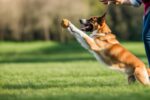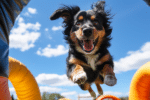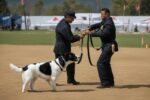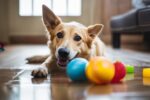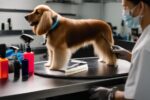Effective Dog Aggression Training
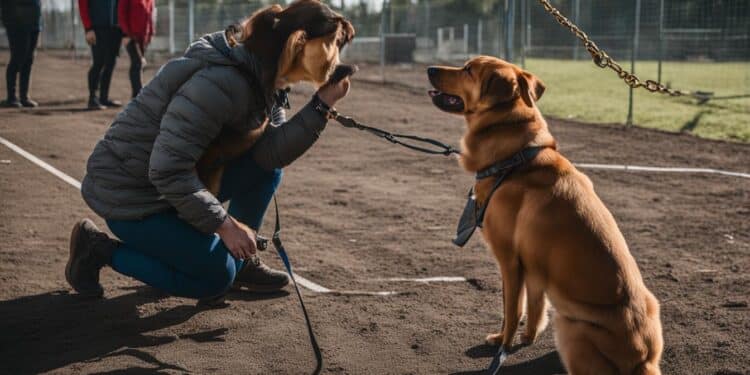
Effective Dog Aggression Training: Are you struggling with dog aggression? Don’t despair. This article will provide you with effective training techniques to address and manage this common issue. By implementing these proven aggression training techniques, you can transform your dog’s behavior and establish a harmonious relationship.
Understanding Aggressive Behavior in Dogs
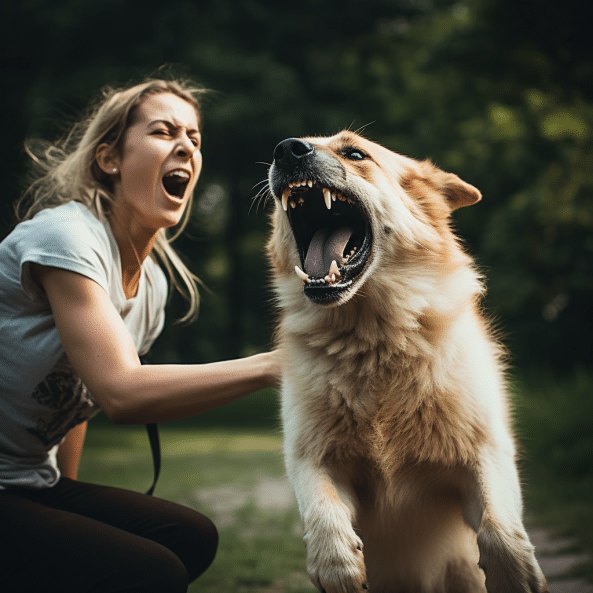
Aggressive behavior in dogs can be distressing and challenging for both pet owners and those around them. It is important to gain a deeper understanding of the root causes of aggression in order to effectively address and modify this behavior. By recognizing the signs and triggers of aggression, pet owners can develop a targeted training approach to create a safer and more harmonious environment for their pets and others.
Signs of Aggressive Behavior
Aggressive behavior in dogs can manifest in various ways, including growling, lunging, snapping, and biting. It is crucial for pet owners to be able to recognize these signs and understand the context in which they occur. Aggression can be directed towards humans or other animals, and it can be influenced by factors such as fear, territoriality, or resource guarding.
To effectively address aggressive behavior, it is important to identify the triggers that elicit these responses in dogs. By understanding the underlying causes, pet owners can design a training plan tailored to their dog’s specific needs, which may involve counterconditioning, desensitization, or other behavior modification techniques.
Causes of Aggressive Behavior
Aggressive behavior in dogs can be rooted in a variety of factors. Fear-based aggression, for example, occurs when a dog feels threatened or fearful in certain situations. This can result from past traumatic experiences or a lack of proper socialization during the critical development stages of puppyhood.
Territorial aggression can arise when a dog feels the need to protect its perceived territory or resources, such as food, toys, or even the home environment. Similarly, resource guarding involves aggressive behavior towards individuals who approach or attempt to take away the dog’s valued possessions.
Understanding the specific causes of aggression in your dog is essential for developing an effective training plan. It is recommended to work with a professional dog trainer or aggression specialist who can provide guidance and support tailored to your dog’s specific needs.
| Common Causes of Aggressive Behavior in Dogs | Training Strategies |
|---|---|
| Fear-based aggression | Desensitization and counterconditioning techniques |
| Territorial aggression | Boundary setting, behavior management, and positive reinforcement |
| Resource guarding | Gradual desensitization, counterconditioning, and resource-sharing exercises |
Importance of Early Socialization
Early socialization is essential to prevent dog aggression. During the critical 3 to 14 weeks, expose puppies to various environments, sounds, and animals for positive associations. This fosters adaptability and confidence, significantly reducing aggression risks as they mature. Controlled interactions with well-socialized adult dogs teach crucial social skills, like play behavior and communication. These positive experiences create a foundation for friendly and non-reactive behavior towards other animals throughout their lives. In this crucial developmental window, gradual exposure shapes a well-adjusted and socially competent adult dog, emphasizing the importance of early socialization for a harmonious canine companion.
| Benefits of Early Socialization | How to Socialize Your Dog |
|---|---|
|
|
Remember, early socialization is an ongoing process that should continue well into adulthood. Regular exposure to new experiences, environments, and social interactions will help reinforce positive behaviors and prevent the development of aggression in dogs. By investing time and effort in early socialization, you can set your furry friend up for a lifetime of happiness and peaceful coexistence.
Positive Reinforcement Training
Positive reinforcement training is a highly effective approach to address aggression in dogs. This method focuses on rewarding desired behaviors and redirecting or ignoring unwanted behaviors. By using positive reinforcement, you can motivate your dog to make better choices and replace aggressive behaviors with more desirable ones.
With positive reinforcement training, you will need to identify the specific behaviors you want to encourage and establish clear cues or commands. For example, if your dog tends to lunge or growl when meeting other dogs, you can use treats or praise to reward them for calm and friendly behavior. Over time, your dog will associate these rewards with positive experiences and be more inclined to exhibit the desired behaviors.
It is important to note that positive reinforcement training should be consistent and timely. Rewards should be given immediately after the desired behavior occurs to reinforce the association. Remember to use high-value treats or rewards that your dog finds particularly motivating to increase the effectiveness of positive reinforcement. Consistency and patience are key to success in using this training method.
Benefits of Positive Reinforcement Training
Positive reinforcement training offers several benefits for addressing aggression in dogs:
- Creates a positive and trusting bond between you and your dog.
- Increases your dog’s confidence and reduces fear or anxiety.
- Helps redirect their focus and energy towards more appropriate behaviors.
- Encourages your dog to make positive choices on their own.
- Strengthens the overall obedience and responsiveness of your dog.
By emphasizing positive reinforcement, you can effectively manage and modify your dog’s aggressive behavior, paving the way for a more harmonious relationship.
| Positive Reinforcement Training Techniques | Description |
|---|---|
| Clicker Training | A clicker is used as a conditioned reinforcer to signal the desired behavior. The sound of the clicker is followed by a reward. |
| Marker Words | Verbal cues such as “yes” or “good” are used to mark the desired behavior, followed by a reward. |
| Treat Rewards | Food treats are given as rewards for displaying the desired behavior. |
| Toy Rewards | Playtime with a favorite toy is used as a reward for exhibiting the desired behavior. |
| Praise and Affection | Verbal praise, petting, and affectionate gestures are used as rewards to reinforce positive behaviors. |
Counterconditioning and Desensitization Techniques for Behavior Modification
Counterconditioning and desensitization techniques are valuable tools for modifying aggressive behavior in dogs. These techniques involve gradually exposing the dog to the triggering stimulus in a controlled and positive manner, with the goal of changing their emotional response and reducing aggression.
Counterconditioning:
Counterconditioning focuses on changing the dog’s emotional association with the trigger. By pairing the trigger with something positive, such as treats or praise, the dog learns to view the trigger as a predictor of good things. This helps alleviate fear or anxiety and reduces the likelihood of aggressive responses.
“Through counterconditioning, we can help dogs replace their negative emotions with positive ones, effectively changing their behavior.”
Desensitization:
Desensitization involves gradually increasing the dog’s exposure to the trigger, starting from a level that elicits minimal or no aggression. The dog is exposed to the trigger in a controlled environment, and as their tolerance improves, the intensity or proximity of the trigger is gradually increased. This process helps the dog build resilience and reduces their exaggerated response to the trigger.
It is crucial to conduct counterconditioning and desensitization under the guidance of a professional trainer or behaviorist to ensure safety and effectiveness. A personalized training plan tailored to your dog’s specific needs and triggers will yield the best results.
| Benefits of Counterconditioning and Desensitization: |
|---|
| Reduces fear and anxiety |
| Changes emotional associations with triggers |
| Increases tolerance to triggering stimuli |
| Helps replace aggressive responses with positive behaviors |
By incorporating counterconditioning and desensitization into your dog’s training program, you can effectively modify their aggressive behavior, helping them become more comfortable and confident in situations that previously triggered aggression.
Behavior Management Strategies
When dealing with dog aggression, implementing behavior management strategies is crucial for aggression prevention and effective training. These strategies help create a safe and controlled environment while working on modifying aggressive behavior.
Using Training Tools
Training tools can be helpful in managing and preventing aggression in dogs. Tools such as leashes, muzzles, and head halters provide additional control and safety during training sessions and in high-stress situations. By using these tools properly and responsibly, you can prevent aggressive incidents and ensure the safety of both your dog and others.
Implementing Structured Routine and Environment
Creating a structured routine and environment is essential in managing dog aggression. Dogs thrive when they have a predictable daily routine and a stable environment. Consistency in feeding, exercise, and training schedules helps reduce anxiety and stress, which are common triggers for aggression. Providing a calm and structured environment also allows you to monitor and address any potential triggers more effectively.
Supervising Interactions and Avoiding Triggers
When working with an aggressive dog, it is important to closely supervise their interactions with people and other animals. This allows you to intervene and redirect their behavior if signs of aggression arise. Additionally, identifying and avoiding triggers that elicit aggression in your dog is crucial. By minimizing exposure to these triggers, you can prevent aggressive incidents and gradually work on desensitization and behavior modification techniques.
| Behavior Management Strategies | Benefits |
|---|---|
| Using Training Tools | Enhances control and safety during training |
| Implementing Structured Routine and Environment | Reduces anxiety and provides stability |
| Supervising Interactions and Avoiding Triggers | Prevents aggressive incidents and allows for intervention and redirection |
By implementing these behavior management strategies, you can create a structured and controlled training environment that promotes aggression prevention and effective behavior modification. Remember to always prioritize your dog’s well-being and consult with a professional trainer or behaviorist for guidance and support throughout the training process.
Seeking Professional Help
When dealing with severe aggression in dogs or if you’re struggling to address the issue on your own, it is highly recommended to seek the help of a professional dog trainer or aggression specialist. These experts have the knowledge, experience, and tools to design a customized training plan to meet your dog’s specific needs effectively.
A professional dog trainer or aggression specialist can provide an objective perspective and unbiased guidance in addressing your dog’s aggressive behavior. They can assess the underlying causes of the aggression and develop a targeted training approach to modify the behavior. They will work closely with you to understand your dog’s history, triggers, and individual temperament, allowing them to tailor a training program that suits your dog’s unique requirements.
Furthermore, a professional trainer or specialist can teach you, as the dog owner, the necessary techniques, and strategies to manage and modify aggressive behavior. They can educate you on how to read your dog’s body language, recognize early signs of aggression, and implement appropriate responses. With their guidance, you will gain the skills and confidence needed to handle your dog effectively and prevent aggressive incidents.
The Benefits of Professional Assistance
Seeking the help of a professional can provide numerous benefits when dealing with dog aggression. Here are a few reasons why professional help is valuable:
- Expertise: Professional trainers and specialists have extensive knowledge and experience in dealing with aggressive dogs. They understand the complex dynamics of canine aggression and can employ effective techniques to address the issue.
- Customized Training: Professionals will create a tailored training plan that addresses your dog’s specific needs, taking into account their temperament, triggers, and behavior history. This personalized approach maximizes the chances of success in modifying aggressive behavior.
- Safety: Aggressive dogs can pose a risk to the safety of both people and other animals. A professional trainer can guide you in using appropriate safety measures, such as muzzles or leashes, while working on behavior modification to prevent any potential harm.
Remember that dog aggression can be a complex issue, and seeking professional help is a proactive step towards addressing the problem effectively. With the guidance of a trained expert, you can navigate the training process with confidence, ensuring the well-being of both you and your dog.
| Benefits of Seeking Professional Help |
|---|
| Expertise |
| Customized Training |
| Safety |
Importance of Consistency and Patience
Consistency and patience are the cornerstones of successful aggression training for dogs. It’s essential to understand that addressing aggression takes time and dedication. By consistently implementing training techniques and maintaining a patient approach, you can effectively modify your dog’s aggressive behavior.
Consistency in training means using the same commands, methods, and rewards consistently. This helps your dog understand what is expected of them and establishes clear boundaries. It’s important to stick to the training plan and avoid sending mixed signals. Dogs thrive on routine and consistency, making it easier for them to learn and make positive changes.
Patience is vital when dealing with aggression. Behavior modification takes time, and progress may be gradual. Set realistic expectations and understand that setbacks may occur along the way. Remember to stay calm and composed, as your emotions can influence your dog’s behavior. By remaining patient and persistent, you can make steady progress in curbing your dog’s aggressive tendencies.
Consistency and patience go hand in hand. Consistently applying training techniques requires patience, as you may need to repeat commands and reinforce positive behavior multiple times. It’s important to keep in mind that every dog is unique, and the training process may vary. Stay committed and adapt as needed to ensure the best outcome for your dog.
“Consistency and patience are key when dealing with dog aggression. It takes time for behavior modification to take effect, and it is important to consistently implement training techniques and reinforce positive behaviors. Patience is also crucial as progress may be gradual, and setbacks may occur along the way. Stay committed and consistent for successful aggression training.”
Consistency and Patience Tips:
- Establish a consistent routine for training sessions, ensuring they occur at the same time each day.
- Use consistent verbal cues and hand signals for commands.
- Reinforce positive behaviors consistently with rewards and praise.
- Avoid rewarding or reinforcing aggressive behaviors, even unintentionally.
- Stay patient and calm during training sessions, as dogs can pick up on your emotions.
- Be consistent with all members of the household, so your dog receives consistent messages.
By practicing consistency and patience throughout the aggression training process, you can effectively address and modify your dog’s aggressive behavior. Remember, every dog is unique, and progress may vary. Stay committed, seek professional help if needed, and remain patient as you work towards a harmonious relationship with your canine companion.
| Key Points | Benefits |
|---|---|
| Consistency | Helps establish clear boundaries and expectations for your dog |
| Patience | Allows for gradual behavior modification and steady progress |
| Consistent Routine | Creates a structured environment for training sessions |
| Positive Reinforcement | Encourages and motivates your dog to make positive choices |
| Emotional Stability | Helps maintain a calm and composed demeanor during training |
Exercise and Mental Stimulation
Regular exercise and mental stimulation are vital components in preventing aggression in dogs. Providing your canine companion with ample physical activity helps release excess energy and reduces the likelihood of pent-up frustration that can lead to aggressive behavior. In addition to exercise, mental stimulation is equally important to keep your dog’s mind engaged and prevent boredom-related behavioral issues.
One effective way to provide mental stimulation is through interactive toys that require problem-solving skills. These toys engage your dog’s cognitive abilities, keeping them mentally stimulated and preventing boredom. Puzzle toys, treat-dispensing toys, and interactive games are excellent options to challenge and entertain your dog. These activities not only keep them mentally engaged but also promote a positive outlet for their energy.
The Benefits of Exercise for Aggression Prevention
Regular exercise helps dogs release built-up energy, reducing the likelihood of frustration and aggressive outbursts. By engaging in physical activities such as brisk walks, jogging, or playing fetch, you can provide an outlet for your dog’s energy in a productive and controlled manner. Exercise also promotes overall well-being and helps maintain a healthy weight, contributing to a balanced and contented mindset.
“Physical activity helps release excess energy while mental stimulation keeps their minds engaged and prevents boredom-related behavioral issues.”
When designing an exercise routine, consider your dog’s age, breed, and individual needs. Different breeds have varying exercise requirements, so it’s important to tailor the activities to suit your dog’s specific needs. For example, high-energy breeds such as Border Collies or Huskies may require more intense exercise sessions, while smaller or senior dogs may benefit from shorter, low-impact activities. Consult with your veterinarian or a professional dog trainer for guidance on appropriate exercise programs for your dog.
| Benefits of Exercise for Aggression Prevention | Examples of Exercise and Mental Stimulation Activities |
|---|---|
|
|
Remember to incorporate both physical exercise and mental stimulation into your dog’s daily routine. By providing these outlets, you can reduce the likelihood of aggression and promote a healthy and balanced behavior in your furry friend.
Avoiding Triggers and High-Stress Situations
Avoiding triggers and high-stress situations is crucial in managing and preventing dog aggression. By identifying specific triggers that elicit aggressive responses in your dog, you can take proactive steps to avoid or minimize exposure to these triggers. This not only helps create a more relaxed and controlled environment but also reduces the likelihood of aggressive incidents.
Stress management plays a vital role in aggression prevention. Just like humans, dogs can experience stress, anxiety, and fear, which can contribute to aggressive behavior. Implementing stress-reducing techniques, such as providing a safe and quiet space, using calming aids like pheromone diffusers or music, and engaging in activities that promote relaxation, can help alleviate your dog’s stress levels and reduce the likelihood of aggression.
Additionally, it is important to establish clear boundaries and rules for your dog. Consistent and fair discipline, combined with positive reinforcement, helps your dog understand acceptable behavior and reduces the risk of aggressive outbursts. By creating a structured and predictable environment, you can help your dog feel more secure and reduce their overall stress levels.
Remember, prevention is key when it comes to managing aggression. By being proactive in avoiding triggers, managing stress, and providing a structured environment, you can significantly reduce the likelihood of aggressive behavior in your dog and foster a safer and more harmonious relationship.
Table: Common Triggers and Stress Management Techniques
| Triggers | Stress Management Techniques |
|---|---|
| Loud noises (e.g., thunderstorms, fireworks) | Provide a safe and quiet space, use white noise or calming music |
| Unfamiliar people or animals | Gradual exposure, positive reinforcement, and reward-based training |
| Territoriality or resource guarding | Implement structured resource-sharing, desensitization, and counterconditioning techniques |
| Physical discomfort or pain | Regular veterinary check-ups, pain management, and appropriate exercise |
| Boredom or lack of mental stimulation | Provide interactive toys, puzzles, and engage in regular training sessions |
Importance of Training for Owners
When it comes to addressing aggression in dogs, training for owners is just as crucial as training for dogs themselves. Understanding dog behavior, learning to recognize early signs of aggression, and practicing appropriate responses are key elements in effectively managing and modifying aggressive behavior. By empowering owners with knowledge and skills, the training process becomes more successful.
Owner training begins with understanding the underlying causes of aggression in dogs. By recognizing the triggers that elicit aggressive responses, owners can implement targeted strategies to prevent and manage aggressive behavior. This may involve avoiding situations or stimuli that provoke aggression and promoting positive associations with previously triggering experiences.
“Training for owners is not about controlling the dog, but about understanding and supporting them. By practicing consistency and patience in training techniques, owners can cultivate a bond of trust and respect with their dogs.”
Additionally, owner training emphasizes the importance of consistent implementation of training techniques and positive reinforcement. By rewarding desired behaviors and redirecting or ignoring unwanted behaviors, owners can motivate their dogs to make better choices and replace aggression with more appropriate responses. Consistency and patience are key throughout the training process, as progress may take time and setbacks may occur.
Understanding dog behavior
One of the primary goals of owner training is to develop a deep understanding of dog behavior. This includes learning to interpret body language, vocalizations, and other communication signals that dogs use to express their emotions and intentions. By understanding these cues, owners can intervene early and prevent aggression from escalating.
Learning about canine body language and behavior also helps owners identify the underlying causes of aggression. Whether it is fear, frustration, or resource guarding, understanding the root cause allows owners to tailor their training approach and implement appropriate behavior modification techniques.
Aggression management
Owner training focuses on effective management of aggressive behavior. This may involve implementing management techniques such as using leashes or muzzles in situations where aggression may be triggered, maintaining a calm and structured environment to reduce stress, and creating a safe training environment for both the dog and the owner.
By actively participating in the training process, owners gain confidence in their ability to manage and modify their dog’s aggression. Through education, practice, and ongoing support, owners play a critical role in shaping their dog’s behavior and fostering a harmonious relationship based on trust and mutual understanding.
| Benefits of Owner Training | Effective Aggression Management |
|---|---|
| Greater understanding of dog behavior | Recognition and prevention of triggers |
| Improved ability to interpret and respond to canine communication signals | Consistent implementation of training techniques |
| Increased confidence in managing aggressive behavior | Positive reinforcement and redirection of unwanted behaviors |
| Safe and structured training environment | Creation of a harmonious relationship based on trust |
Addressing Fear-Based Aggression
Fear-based aggression is a common type of aggression seen in dogs. It is crucial to understand that fear is the underlying emotional trigger for this behavior. When a dog feels threatened or scared, they may respond by displaying aggression as a way to protect themselves or communicate their discomfort. To effectively address fear-based aggression, desensitization techniques can be employed in a controlled and positive manner.
Desensitization involves gradually exposing the dog to the fear-inducing stimulus, starting with a low-intensity version and gradually increasing the intensity as the dog becomes more comfortable. The goal is to change the dog’s emotional response from fear to a more positive or neutral association. This process requires patience, consistency, and careful observation of the dog’s body language to ensure that they are not becoming overwhelmed or stressed.
Desensitization can be combined with counterconditioning, which involves associating the fear-inducing stimulus with something positive, such as treats or praise. This helps the dog form a new positive association with the previously fear-inducing stimulus. By repeatedly exposing the dog to the stimulus in a controlled and positive manner, fear-based aggression can be successfully addressed over time.
Addressing Resource Guarding
Resource guarding is a common behavior in dogs where they become possessive and aggressive over valuable resources such as food, toys, or territory. It is important to address this behavior through behavior modification techniques to ensure a safe and harmonious environment for both the dog and its owners.
One effective approach to address resource guarding is gradual desensitization. This involves teaching the dog to associate the presence of others near its resources with positive outcomes. By slowly introducing the dog to situations where its resources are approached and rewarding calm and non-aggressive behavior, the dog learns to feel more secure and less possessive.
Behavior modification for resource guarding also involves promoting the concept of resource sharing. This can be done by training the dog to willingly give up its resources in exchange for a reward. By consistently reinforcing positive behavior during resource exchanges and gradually increasing the difficulty level, the dog learns that sharing resources leads to positive outcomes.
Example:
“Resource guarding is a natural behavior for dogs, but it can become problematic if it leads to aggression. Through behavior modification techniques such as desensitization and promoting resource sharing, we can help dogs overcome possessive aggression and create a more harmonious living environment.” – Certified Dog Trainer, Jane Smith
Addressing resource guarding requires patience, consistency, and a thorough understanding of the dog’s behavior. Seek professional guidance if needed to ensure the safety and well-being of both the dog and its owners. By implementing behavior modification techniques, resource guarding can be effectively managed, reducing the risk of possessive aggression and creating a trusting and respectful bond between the dog and its human companions.
| Resource | Description |
|---|---|
| Food | The dog may growl, snap, or bite when someone approaches its food bowl or tries to take away food. |
| Toys | The dog may become possessive and aggressive when someone tries to take away its toys or playthings. |
| Territory | The dog may exhibit aggressive behavior when someone enters its perceived territory, such as its bed or designated space. |
The Role of Diet and Health
When it comes to managing aggression in dogs, the role of diet and overall health should not be overlooked. A balanced and nutritious diet is crucial for promoting your dog’s overall well-being and can have a positive impact on their behavior. By ensuring that your dog is receiving the necessary nutrients, you can help prevent potential underlying health issues that may contribute to aggression.
Proper nutrition plays a vital role in supporting your dog’s physical and mental health. It is important to provide them with a high-quality diet that meets their nutritional needs. Consult with your veterinarian to determine the most suitable diet for your dog’s age, breed, and specific health requirements.
In addition to a healthy diet, regular veterinary check-ups are essential for addressing any potential health problems. Physical ailments such as pain, discomfort, or hormonal imbalances can sometimes manifest as aggressive behavior in dogs. By addressing these underlying issues, you can help alleviate their aggression and improve their overall well-being.
Key Points:
- A balanced and nutritious diet is crucial for promoting your dog’s overall well-being and behavior.
- Consult with your veterinarian to determine the most suitable diet for your dog’s specific needs.
- Regular veterinary check-ups are important for addressing any potential physical causes of aggression.
| Diet and Health Tips |
|---|
| Provide a balanced and nutritious diet: Ensure your dog’s diet contains the necessary nutrients for their well-being. |
| Consult with your veterinarian: Seek professional advice to determine the most suitable diet for your dog. |
| Schedule regular veterinary check-ups: Monitor your dog’s health and address any potential underlying issues. |
| Pay attention to portion control: Avoid overfeeding and maintain a healthy weight for your dog. |
| Consider dietary supplements: Some supplements can support your dog’s overall health and behavior. |
Monitoring Progress and Seeking Continuous Training
Monitoring your dog’s progress throughout the aggression training process is crucial for assessing the effectiveness of your training techniques and making adjustments as needed. Keep a close eye on your dog’s behavior changes and improvements over time. Record any instances of reduced aggression, increased obedience, or positive responses to training cues. This progress monitoring allows you to track your dog’s development and provides valuable insights into the success of your aggression management strategies.
Additionally, seeking continuous training is essential to maintain and reinforce the progress made. Ongoing training helps solidify the desired behaviors and prevents regression. Consistency and practice are key in ensuring your dog’s long-term success in managing aggression. Engage in regular training sessions, focusing on reinforcing positive behaviors and providing mental stimulation. This continuous training not only helps prevent aggression but also strengthens the bond between you and your dog.
Remember that aggression management is an ongoing process, and it requires dedication and commitment. Be patient with your dog as progress may be gradual, and setbacks may occur. Stay consistent with your training techniques, incorporating positive reinforcement and behavior management strategies. Seek guidance from a professional dog trainer if needed to fine-tune your training plan and address specific challenges. With regular monitoring and continuous training, you can effectively manage and prevent aggression in your canine companion.
Conclusion
Dealing with dog aggression requires a comprehensive approach that combines effective training techniques, consistency, and patience. By understanding the root causes of aggression, implementing positive reinforcement methods, and seeking professional help when needed, you can successfully manage and modify aggressive behavior in your dog.
Throughout the aggression training process, it is essential to prioritize your dog’s well-being and safety. By investing time and effort in understanding and addressing the underlying triggers of aggression, you can create a harmonious and balanced relationship with your canine companion.
Remember that aggression training is a gradual process, and results may vary depending on the individual dog and their specific needs. It is important to monitor your dog’s progress, celebrate small victories, and seek continuous training and reinforcement of desired behaviors to ensure long-term success in managing and preventing aggression.
By applying the strategies and techniques discussed in this article, you can transform aggression into obedience, promoting effective aggression management and a peaceful coexistence with your furry friend.
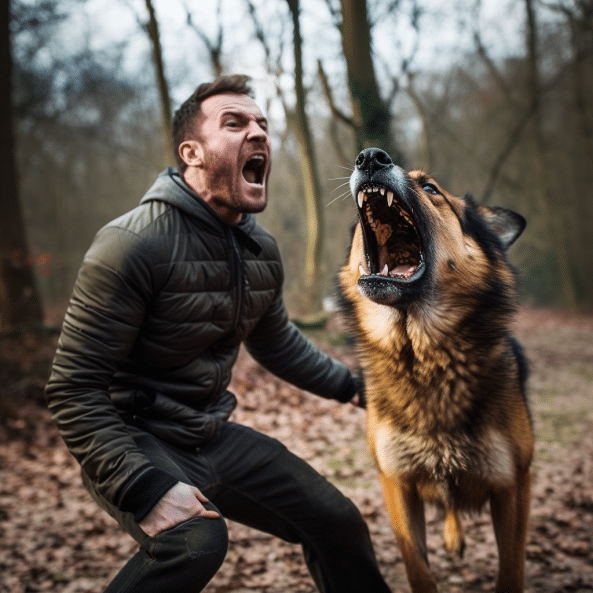
FAQ
What are the most effective training techniques for managing dog aggression?
Positive reinforcement training techniques, which focus on rewarding good behavior, are considered the most effective for managing dog aggression.
Are aversive conditioning techniques, such as the use of pronged, shock, or choke collars, recommended for managing dog aggression?
No, aversive conditioning techniques are considered harmful and can potentially make dogs more aggressive. These methods should be avoided in favor of positive reinforcement training.
When should training collars be introduced in aggression training?
It is important to establish basic commands before introducing training collars. When using training collars, always start with the lowest possible setting and monitor the dog’s reactions.
How long should training collars be used during aggression training?
Training collars should be used for short periods of time and should not cause any discomfort or irritation to the dog.
Is the dog training industry regulated?
No, the dog training industry is currently unregulated. However, there are calls for stricter regulations to ensure the use of humane and effective training methods.
